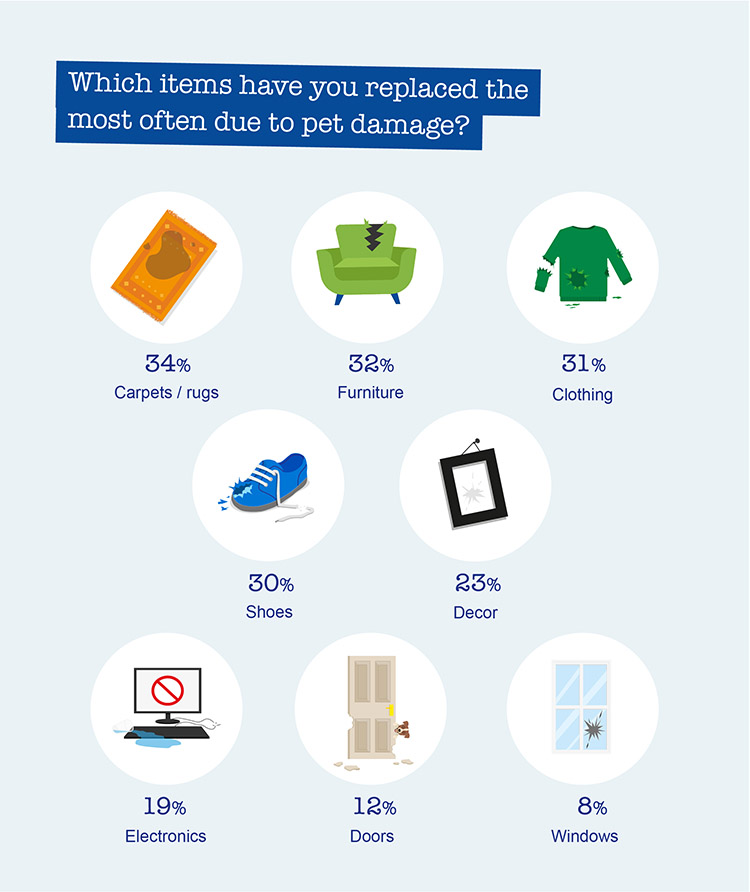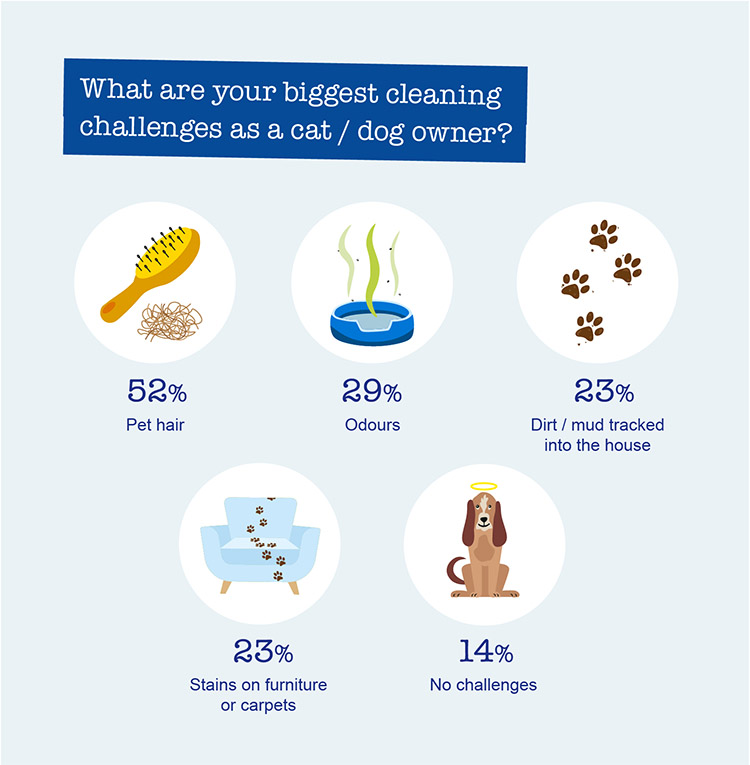Pet-proof your home with expert tips from Petplan. Protect pets from hazards, prevent damage, and keep your space safe and stylish for everyone.
Home is where the heart is, but it’s also where the hazards are. From poisonous plants to cables, chemicals and yes – chocolate – we all have to prepare for various pet perils. And as cute as they are, our beloved pets can cause damage to our home environment – from carpets to clothing.
To scratch beneath the surface, we surveyed more than 1,100 UK dog and cat owners to explore their experiences of pet-related damage – and how it can be prevented.
- More than four out of ten (41%) cat and dog owners (and 50% of Londoners) have replaced household items due to damage caused by pets.
- On average, pet owners are replacing furniture or household items twice a year due to pet-related damage.
- Carpets or rugs (34%) are the most frequently replaced item. More than a fifth (21%) of pet owners have bought a sofa cover – the most popular pet-proofing remedy.
- Pet hair was revealed as the public’s biggest pet cleaning challenge – cited by 52% of respondents, rising to 63% in Brighton.
- 36% of respondents in the North East say they’ve taken no steps to pet-proof their home – the highest of any region.
Sniffing out the danger
Our homes are places to relax, unwind and chew on a bone or two. But pets can be harmed by hidden household hazards:
- Chocolate (particularly dark chocolate) contains a chemical that can be fatal to cats and dogs. No matter how delicious, those cakes, sweets and cookies need to be stored safely.
- Vapes and e-cigarettes are dangerous to pets as they contain highly toxic nicotine. The casing, battery and e-liquid can cause serious harm – and even death – if ingested by animals.
- Garden chemicals, such as weed and pest killers, present a danger to pets if swallowed or exposed to their skin. Keep that shed firmly shut!
So the dangers are clear. But are pet owners prepared?
Are Brits aware certain household items can be harmful or toxic to pets such as dogs and cats?
Many common household items can be harmful or toxic to pets, but not everyone is aware of the risks:
- 66% of people know that common cleaning products can harm pets like dogs and cats.
- 57% of people are aware of the dangers posed by garden chemicals.
- 43% of people recognise the risk of certain plants being toxic to their furry friends.
But here’s the surprising part: 12% of people didn’t know any of these items could be harmful.
If we dig a little deeper, our survey found differences across age, gender and geography in pet owners’ perception of household risks.
Just 58% of 16-24-year-olds are aware that common cleaning products can be toxic to pets, compared to 75% of over 55s. Meanwhile, 32% of male pet owners versus 53% of females say they’re aware that plants can be toxic to pets.
And across the UK, people in Cardiff and Glasgow had the highest net confidence (93%) in identifying harmful or toxic risks, whereas Sheffield had the lowest (79%).
The price of pet damage
There are many ways to reduce the risks to our pets, but what about when the roles are reversed? Let’s face it – we could all do without scratch marks on the sofa.
More than four in ten (41%) cat and dog owners (and 50% of Londoners) told us they’ve had to replace household items due to pet-related damage. And on average, pet owners are replacing furniture or household items twice a year due to pet damage.

Pet ownership is changing, with a rapid rise in the number of indoor cats in the UK. So naturally, millions of us want to live in homes that are cat-friendly (and cat-proofed).
Younger pet owners were more likely to say they’d experienced pet damage. 63% of 16-24-year-olds said they’ve replaced household items damaged by pets, compared to only 26% of over 55s.
Similarly, 34% of 16-24-year-olds said they replace damaged items every two to five months, whereas only 6% of over 55s replace items this frequently.
“Scratching is a natural behaviour for cats, but it can wreak havoc on your sofa if your cat is not given an appropriate outlet for their scratching. Stop your cat from scratching furniture by making the area less appealing. Wash previously scratched spots with laundry liquid or disinfectant to remove their scent. Then cover the area with materials cat’s dislike, like foil, polythene, sandpaper, or decorator's flooring protection film.”
“Providing suitable scratching posts in areas where your cat is scratching (for example, next to sofas) as well as close to where they sleep (as they tend to scratch when they first wake up) and near entry and exit points (for scratch marking) and rewarding them for using those instead of furniture can make a big difference.”
- Nicky Trevorrow, Behaviour Manager at Cats Protection
“Chewing is especially common in dogs, particularly puppies, as they explore the world or soothe teething discomfort.”
“The key is to offer plenty of chew-safe toys and rotate them regularly to keep your dog engaged. If chewing becomes a problem, it can be a sign they need more mental or physical stimulation, or that they may be suffering from other anxiety related conditions such as separation anxiety- an experienced behaviour specialist will be able to help you identity the reason behind excessive chewing.”
- Nick Jones, Petplan Pet Expert and dog behaviourist
We’re not pointing fingers (or mucky pawprints), but it’s perhaps a reminder of the importance of dog training; after all, you can teach an old dog new tricks.
Our biggest pet peeves
We all love our cats and dogs, but there are sometimes those moments when… well, we can find things a little challenging.

Nobody’s purr-fect, but across the board, we pet owners aren’t exactly thrilled about the sights and smells our pets introduce to our home. However, our survey found some differences of opinion.
- Males (56%) were more likely than females (46%) to cite pet hair as a cleaning challenge.
- People in Brighton (63%) were the most likely to cite pet hair as their biggest cleaning bugbear.
- Elsewhere, 43% of Liverpudlians said ‘odours’ were the biggest pet challenge – the highest response of any city. Londoners were the most likely (30%) to cite stains on furniture or carpets.
- Almost a fifth (19%) of over-55s have got it sussed – they reported no big pet cleaning challenges.
How to pet-proof a home
Actions speak louder than purrs, so we wanted to know what pet owners are doing to keep their humble abode looking (and smelling) its best.
While almost a quarter (24%) said they’re taking no measures, other pet owners are getting creative.
What steps have you taken to pet-proof your home?
| Bought a sofa cover | 21% |
| Closed the door to certain rooms which might be hazardous | 20% |
| Covered the bin | 19% |
| Used non-toxic cleaners | 18% |
| Removed/hidden poisonous plants | 17% |
| Got a dog/cat flap | 17% |
| Bought cushion covers | 13% |
| Got a new fence/barrier | 13% |
| Added in a baby/pet stair gate | 13% |
| Secured windows | 12% |
| Changed the flooring | 11% |
| Used sprays to deter my pet from furniture | 10% |
| Covered plug sockets/got cable protectors | 10% |
| Changed or replaced curtains | 8% |
| Other | 1% |
Across the generations, older people appear less likely to proactively pet-proof their home. For example, 36% of adults aged 55-plus said they’ve taken no pet-proofing steps, compared to 10% of 25-34-year-olds.
Regionally, 36% of North East pet owners haven’t taken any measures to pet-proof their home – the highest among all regions. Newcastle (also 36%), Edinburgh (33%) and Norwich (33%) were the cities where people were most likely to have taken no action.
“We all love our pets, but unless we’re proactive as pet owners, there is always a price to pay. From damaged carpets to ruined clothes, a lack of effective training can make our home environment less relaxing than it should be.”
“Equally, a failure to pet-proof our homes presents real risks to cats and dogs. And with the relative rise of pets that live indoors, it’s more important than ever that we learn how to create a pet-friendly home, as well as ensure you’re insured should they get into anything.”
- Dr Brian Faulkner, Petplan vet expert
Tips for pet-proofing your home
To keep your pet safe:
- Avoid poisonous plants like ivy and lilies. Move plants or flowers to a higher level if you’re unsure.
- Ensure cleaning products are out of reach and locked away.
- Safeguard outbuildings with cat flaps so they don’t get stuck.
- Keep bins covered and keep poisonous foods out of reach.
- For cats, keep rope/ string based toys out of reach when not playing.
- Use a child-gate or dog-gate to keep your pets away while you’re cooking.
- Keep vapes, medication and e-liquid bottles shut in a secure container, out of reach.
To protect your furniture:
- Introduce scratching posts to protect your sofa.
- Invest in covers for chairs and sofas.
- Invest in chew toys so they don’t chew table legs etc.
- Consider training pets not to go on furniture.
- Use safe scents such as lavender or citrus to deter cats from scratching.
- Groom pets regularly to keep excess pet hair under control.
- Loop your curtains so they can’t be clawed (but avoid tie-back cords).
- Use clean litter trays for cats. Give puppies regular toilet breaks.
We surveyed 1,165 UK respondents who own a cat and/or a dog between 29.11.2024 and 2.12.2024 to understand their attitudes towards pet-proofing their home.